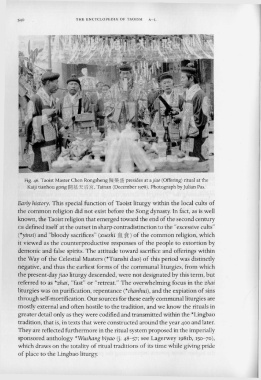Page 581 - The Encyclopedia of Taoism v1_A-L
P. 581
54 0 T HE ENCYCLOPED IA OF TAO ISM A- L
Pig. 46. Taoist Master Chen Rongsheng 1~~Jl1Ir presides at ajiao (Offering) ritual at the
Kaiji tianhou gong I*l M:x 1fi g . Tainan (December (978). Photograph by Julian Pas.
Early history. This special function of Taoist liturgy within the local cults of
the common religion did not exist before the Song dynasty. In fact, as is well
known, the Taoist religion that emerged toward the end of the second century
CE defined itself at the outset in sharp contradistinction to the "excessive cults"
(*yinsi) and 'bloody sacrifices" (xueshi lflI.1t) of the common religion, which
it viewed as the counterproductive responses of the people to extortion by
demonic and false spirits. The attitude toward sacrifice and offerings within
the Way of the Celestial Masters (*Tianshi dao) of this period was distinctly
negative, and thus the earliest forms of the communal liturgies, from which
the present-day jiao liturgy descended, were not designated by this term, but
referred to as *zhai, "fast" or "retreat." The overwhelming focus in the zhai
liturgies was on purification, repentance (*chanhui), and the expiation of sins
through self-mortification. Our sources for these early communal liturgies are
mostly external and often hostile to the tradition, and we know the rituals in
greater detail only as they were codified and transmitted within the *Lingbao
tradition, that is, in texts that were constructed around the year 400 and later.
They are reflected furthermore in the ritual system proposed in the imperially
sponsored anthology *Wushang biyao (j. 48-57; see Lagerwey 198Ib, 150-70),
which draws on the totality of ritual traditions of its time while giving pride
of place to the Lingbao liturgy.

